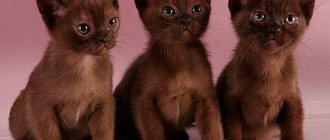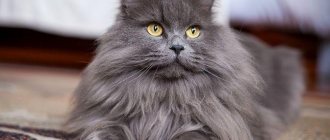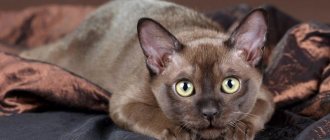The Burmese or Burmese cat is a delightful animal, the embodiment of grace, charm and charisma. This beauty can rightfully be considered a royal, she looks so majestic. And in terms of character, it’s just a godsend. Friendly, good-natured and affectionate creature. Therefore, it is worth talking about this breed in more detail.
Burmese cat
Brief information and highlights
The Burmese cat is a short-haired cat with an overly active temperament. It seems that to this day the golden-honey echo of the sun of the Ancient East - the historical homeland of the Burmese - shines in her eyes. Few will remain indifferent after becoming closely acquainted with this charming creature both in appearance and character. The breed differs from its fellows in its extraordinary intelligence, prudence and wisdom.
According to ancient beliefs, Burmese cats bring happiness and prosperity to the home. Provided that the owner and all members of his family truly become friends with the pet.
Short Description:
- the official name of the breed is the Burmese cat;
- place of origin - the ancient state of Burma;
- the average weight of the animal is 6-9 kg;
- life span – 11-16 years.
Key aspects:
- Burmese cat is a true dog in cat form, which is not inferior in affection and love to its owner. I am ready to be with him around the clock.
- Despite its impressive dimensions, this extremely graceful, elegant animal is a clear paradox. That’s why such representatives are often called “bricks in silk clothes.”
- There are two varieties of Burmese cats - American and European. They differ in appearance from each other.
- Playfulness and cheerfulness remain among the Burmese into old age. Even older individuals will not mind chasing a ball or other object thrown by the owner.
- The animal intuitively understands what mood the owner is in. If he is not in a good mood, he will not bother him with his presence or, on the contrary, will try to cheer him up.
- These cats do not require privileged living conditions. So anyone can have it at home, even those who have decided to do so for the first time.
- Burmese do not conflict with other domestic animals living in the neighborhood. But, only in the absence of hostile manifestations on their part.
- Burminese are suitable for families with children. Exotic cats are lenient towards children and are ready to play around with them and play mischief.
- Burmese are naturally intellectually developed and easy to train.
Feeding
Cats of this breed have a good appetite. This must be taken into account when creating a menu. The food must be balanced and contain the required amount of vitamins.
To feed your pet, choose super-premium food. It is desirable to have large kibble in the food, which will prevent the formation of plaque and help get rid of tartar.
If the owner prefers natural feeding, you need to diversify the pet’s diet with boiled or stewed vegetables, cottage cheese and cheese.
Do not give your animal sausages, sausages, smoked meats or other unhealthy foods!
Breed characteristics
Brief card:
| Characteristic | Score out of 5 points |
| Mobility, playfulness | 3-4 |
| Affectionateness | 5 |
| Predisposition to shedding | 2 |
| Need for constant care | 1 |
| Health | 4 |
| Communication skills | 4 |
| Peacefulness, friendliness | 4 |
| Intellectual capabilities | 5 |
She won't destroy your home
There are fidgety cats that spoil the interior. Some scratch wallpaper and furniture purely on principle. Burma will never do this. She is not used to taking revenge on her owner because of her own self-sufficiency.
Polina Dibrova honestly answered the question of whether she would fall in love with a simple security guard
I washed myself with perfume, sacrificing lunch: the unknown life of the artist Mikhail Vrubel
Yogurt, fruit and other popular foods that you shouldn't eat for breakfast
The Burmese cat is very playful and loves to play hide and seek. At the same time, she is unobtrusive and will not follow the owner’s heels or impose her company if he is not in the mood for communication.
It is curious that the Burmese have their own hierarchy. She considers herself the most important in the family, even if there are other pets, including dogs. He treats his owner with respect, so he tries not to cause him any special troubles or problems.
Origin story
Exotic beauty
The ancient state of Burma (now Myanmar) became famous for its amazingly beautiful panoramas and attractiveness, characteristic exclusively of Asian countries. Here, nature untouched by human hands contrasts with the jungle, snowy mountain tops and snow-white beach sand with the rocky buildings of cities. It is in Asia that the Burmese cat breed takes its historical origins.
The first time people heard about Burma was in the 12th century. Later, these mysterious cats were repeatedly mentioned in ancient scriptures. Confirmation of the ancient origin of the breed is the images in the dogmas of Siamese painters, who in appearance were very similar to our modern beauties.
Burmese felines have been revered among the population of Burma since ancient times. They were even allowed into temples because they were considered higher beings. The monks tried to provide them with maximum care and attention. In this way they demonstrated their devotion to religion.
According to one of the beliefs, Burmese escort the soul of their deceased owner to the other world, providing him with eternal peace. And according to another legend, these cats bring good luck and prosperity to the house. Therefore, such pets were mainly owned by aristocratic and royal families.
The Burmese first appeared in Great Britain at the turn of the 19th – 20th centuries. They were originally called "black Siamese". Gradually they began to spread further. It is noteworthy that the ancestor of the Burmese breed was not a purebred representative, but a Burmese cat with a cross of a Siamese. Retired naval doctor Joseph Thompson took an active part in breeding new individuals. His like-minded people were scientists from the University of California and local cat lovers from the felinological club.
The Wong Mau kitten, which a doctor accidentally acquired, looked very similar to a Siamese. Therefore, a Siamese partner named Tai Mau was chosen for crossing. In the first litter there were seal point and rich nut colored kittens. For subsequent breeding of Burmans, the choice fell on chestnut-colored babies. During subsequent attempts, 3 colors were obtained: chocolate and tan, dark brown and sable. The doctor liked the last option the most.
Thanks to the experience and diligence of felinologists, real Burmese cats were presented to the world in 1934. The breed was registered in the same year. And a couple of years later, the CFA Corporation developed a unified standard for Burmese.
These cute creatures immediately attracted the attention of the masses, but the number of animals was small. In this regard, they decided to cross the Burmese representatives with Siamese, which matched in color. As a result, many mestizos arose; they ceased to be registered in 1947. From then on, every newborn had to be tested for pure blood pedigree (at least the previous three generations). The Americans were actively involved in reviving the breed; registration of Burmese was resumed in 1957. The global standard was developed a year later by the UBCF organization and has not changed to this day.
True, the American and English individuals clearly differed in appearance. Therefore, another standard soon appeared - the European one (it is not yet recognized by the CFA).
Keeping Burmese at home
The Burmese cat is an ideal creature to keep at home, and this is not due to ancient myths. They are very clean, flexible and friendly. If you are rarely at home, then I must say that it will be very difficult for your pet to endure separation.
To prevent the cat from being injured or injured, it is necessary to remove all fragile and unstable objects from shelves and cabinets, especially at a young age, Burmese cats, due to their natural curiosity, will definitely want to check them and may break them. You should also remove household chemicals; small kittens may want to taste them.
It is not recommended to let Burmese go outside for walks, but you can take them out on a leash. If you are relaxing at the dacha, then you can let them go for a walk in your area. Just remember about vaccinations and other means of protection; you also need to buy a flea collar.
Care, hygiene
Burmese cats are unpretentious in care. The Burmese has short hair without undercoat, so it is not necessary to comb it often; once every 10-15 days will be enough. Water procedures can be carried out two to three times a year.
They tolerate the washing process calmly, as they unconditionally trust their owner. The Burmese's ears and eyes should be cleaned as needed, usually once a month. It is recommended to trim claws once every two months.
Diet - what to feed the Burmese
Premium and super premium food is suitable for adult Burmese cats.
This is very important, since they optimally contain all the vitamins necessary to maintain the cat’s health. Burmese kittens need to include lean fish in their diet, which must be boiled first. In addition to wet food, the diet should also contain dry food, this will help in the fight against tartar
In addition to wet food, the diet should also contain dry food, this will help in the fight against tartar.
Elderly cats should be given natural food, this can be rabbit meat, chicken, or less often beef. It is advisable to make minced meat, since it is difficult for old animals to chew solid food. Pregnant and lactating Burmese need increased nutrition, for this you can increase the dose of regular food or buy a special one; now you can find these in stores.
The main thing is not to feed the Burmese with food from the table, since salty, spicy and fatty foods can significantly affect their health.
Diseases, breed defects
Burmese cats have a number of extremely unpleasant diseases. This is the only significant drawback of the Burmese, both European and American. This often discourages people from purchasing these cute creatures. However, if you are careful when purchasing them, you can avoid such problems.
Gangliosidosis is a fairly common hereditary disease of the nervous system that manifests itself at an early age in the form of lameness and paralysis. This disease leads to the death of the animal in all cases. This disease cannot be treated. Modern scientists are trying to solve this problem, but so far to no avail.
Hypokalemia, this disease manifests itself in the form of general lethargy of the animal and increased fatigue. It is treated by administering drugs containing potassium ions, otherwise paralysis is possible.
Flat chest syndrome is also a characteristic disease of the Burmese. This disease can be detected in the first days of life. This imbalance of the chest muscles leads to disability of the individual. In rare cases, Burmese kittens survive this disease and everything returns to normal. There is currently no treatment.
The eyes and ENT area are another weak point of the breed. Treatment must be prescribed on a case-by-case basis by a veterinarian. Since there are several causes of this disease.
Appearance of a Burmese cat
Despite their external sophistication and sophistication, the Burmese turn out to be very heavy (if you pick them up in your hands). For this they are jokingly called bricks. Males always weigh more than females, by about 2 kg.
In short, the Burmese cat is listed as a short-haired breed of medium size. Belonging to a certain standard (American or European) is determined by the appearance of the animal. In this section we will consider the American type of Burmese.
American Burmese
Dimensions and weight
Burmese are medium-sized, ideally built animals. Despite their apparent lightness, they are quite heavy. An adult Burmese cat weighs about 8-9 kg, a female cat weighs about 5-7 kg.
Cat development table by month:
| Age by month | Girl | Boy |
| 1 | 350-500 grams | 450-750 grams |
| 2 | 500-800 grams | 650-1600 grams |
| 3 | 1.20-1.70 kg | 1.5-2.5 kg |
| 4 | 1.70-2.5 kg | 2-3.6 kg |
| 5 | 2.25-3.40 kg | 2.45-4.30 kg |
| 6 | 2.5 -3.7 kg | 3-5.8 kg |
| 8 | 3-4.40 kg | 3.6-6.4 kg |
| 10 | 3.4-4.9 kg | 5.2-7.3 kg |
| 12 | 3.5-5.5 kg | 6-7.8 kg |
| 24 | 3.9-6.5kg | 8-9 kg |
Head and skull
Slightly widened with a slight narrowing downwards. The forehead has a slightly rounded shape. Upon close examination of the animal's head in front and profile, flattened zones are noticeable.
Muzzle
It has clearly defined outlines that are in harmony with the graceful contours of the head as a whole. The bridge of the nose is clearly visible and the cheekbones stand out. A powerful chin forms a vertical line together with the tip of the nose. American Burmese have a wider and shorter muzzle than European Burmese.
Ears
They have a triangular shape, wider at the base, gradually tapering to rounded tips. Planted at a great distance from each other. The ears are slightly tilted forward, so it seems that the cat is always on the alert.
Eyes
They are located far from each other. They are very voluminous in size and very expressive. The characteristic oriental shape of the eyes (the outer tips are raised) gives the Burmese a resemblance to orientals. The iris of cats shimmers in different shades of yellow: from soft honey to rich amber (a golden tint is preferable). With age, Burmese eyes fade and become less bright.
Jaws and teeth
The lower part is more pronounced than the upper. Therefore, it stands out and is visible to the naked eye in profile. The bite is normal.
Neck
Burmese cats are characterized by a sophisticated long neck, and quite strong.
Frame
Slender, compact body, with clearly visible muscles. The chest is particularly developed and has a rounded outline. The back is flat from the shoulder girdle to the beginning of the tail.
Tail
Smooth (without bends), not long, but you can’t call it short either. It is not very wide at the base, gradually narrows towards the tip and forms a roundness there.
Limbs
Thin (but not skinny), medium in length. The paws are gracefully shaped in the form of oval pillows. The number of toes on the front paws is five, on the hind paws - four.
Coat
Representatives of this breed are characterized by a short and thin coat. It fits tightly to the body, there is practically no undercoat. Upon tactile contact, the fur is very pleasant: smooth, silky. It shimmers spectacularly with every movement of the animal.
Color
Burmese colors
The Burmese's upper body is always darker than the lower part (regardless of color). A uniform tone is preferred, but slight inclusions on the face, ears, legs and tail are acceptable. Kittens have a tiger pattern on their bodies, which disappears as they grow older.
Recognized color standards:
- blue;
- sable;
- platinum;
- chocolate.
Now you can find Burmese turtles, as well as red and cream colored ones.
Physical activity
The Burmese cat remains playful until old age, and this is strikingly different from other cats, which frolic only in their youth. This prolonged activity is explained by the delayed maturation of the Burmese, which at 12 years old looks no less impressive than at 2 years old.
Breeders note the cat's regal plasticity, reminiscent of the light and free movements of jaguars and leopards. The Burma does not lose its innate grace even in a state of rest. By the way, she is often caught contemplating an aquarium or life outside the window: during these periods the cat rests, achieving mental balance.
Few domestic cats can compare with the Burmese in beauty and complexity of acrobatic tricks, interspersed with ballet jumps.
Interesting! Thanks to its powerful muscles, the Burmese is able to soar up and land softly without noticeable muscle tension. With a vertical start, it costs nothing for the cat to reach your height and land on your shoulder.
The Burma loves to bask in arms, but when the hugs become too intrusive, she slips out of them like mercury.
Walking with a Burmese
This topic causes a lot of controversy among owners of Burmese cats, many of whom are convinced that walking outside (as one of the types of physical activity) is necessary for animals.
Indeed, wild and stray cats are not limited in their movements: they search for prey, roam and guard areas. But free walking of domestic cats (without the supervision of owners) is possible only in rural areas or in the country.
The owner is entirely responsible for exercise within the city, which is fraught with all sorts of troubles: a cat can be injured by glass shards, get hit by a car, eat a dead pigeon or a poisoned rodent, or be harmed by dogs.
Important! Free walking of purebred animals (and Burmese cats are no exception) is, as a rule, prohibited by the regulations of the breed club.
If you do take your Burmese out into the fresh air, make sure it is vaccinated and also treat its fur with insecticides (those that repel ticks). It is these parasites that carry piroplasmosis, which most often kills not only cats, but also dogs.
Particularly careless people let cats out onto the balcony/loggia. This is quite acceptable in a glassed-in space, but extremely dangerous in an open one. Undoubtedly, there are tailed flyers who have made (without any consequences to their health) several jumps without a parachute.
But it’s better not to take risks. By the way, the taboo on walking on an unfenced balcony is often included in the Burmese purchase and sale agreement or in the club rules.
How to train a leash and harness
A walk will turn into torture if you do not accustom your pet to a leash and harness in advance: a collar (due to poorly developed neck muscles) is contraindicated for cats.
A tape measure for small dogs can act as a leash. The harness is selected so that two fingers fit freely between it and the body.
Important! The skill of putting on and carrying equipment without complaint will be useful during walks, during visits to the clinic or to the groomer. A young animal gets used to a leash/harness quite quickly, but an adult animal gets used to it much harder.
Accustoming a Burmese to a harness consists of several stages:
- Place the harness where the cat likes to play and relax so that she gets used to the unfamiliar thing.
- Occasionally try to put your pet in a harness, encouraging him with affection and treats. Let the cat think that they are playing with it.
- When the cat has come to terms with the new piece of clothing, do not remove the harness, gradually increasing the time it stays in it.
- To make the harness evoke pleasant associations, put it on, for example, before feeding.
- As soon as the cat stops noticing the harness she is wearing, add a second accessory, a leash, and walk around the apartment.
If all stages are successfully completed, go out with the Burmese, choosing a quiet and deserted place. The harness must be put on before leaving the house, and the cat must be placed in a carrier already in its gear.
Place the container on the ground, open it and wait for the animal to come out. Pulling a Burmese cat like any other cat is completely useless, so be prepared that it will be the one who will chart the route, not you.
Return to content
Difference between American and European Burmese
Burmese is a generic name that includes two varieties of the breed: American and European. Both representatives are incredibly beautiful and graceful. They fascinate with their penetrating panther gaze. But they differ in appearance, as can be seen in the photograph.
On the left is an American Burmese, on the right is a European Burmese
Difference in coat color
The American standard implies 4 colors:
- sable;
- champagne;
- blue;
- lilac.
European representatives can be in the following colors:
- brown;
- lilac;
- scarlet;
- chocolate;
- blue;
- cream;
- tortoiseshell: with a cream, blue, chocolate or lilac tint.
Differences in the eyes
The American class of Burmese have large and round eyes, far apart. Therefore, these creatures always look childishly touching.
Krgulye
“Europeans” have equally large eyes at a considerable distance from each other, the upper eyelid slopes toward the line of the nose, and the lower eyelid is slightly rounded. They have a sullen look, giving the cat a stern look - this is their distinctive feature.
Severe
Ears
American Burmese have small ears, wide at the base and rounded at the ends. They are wider apart than those of European representatives. The latter's ears are set quite low and tilted forward. Set wide. They are larger in size than the “Americans”. The outer edge of the ears is in line with the cheeks.
According to the shape of the head
American individuals differ in head shape from European ones by being more rounded and fuller in all forms. Euroburms have a wedge-shaped, blunted skull with a slight rounding between the ears.
In the face
The muzzle of the American Burmese is round with large, surprised eyes. The European breed has a triangular-shaped muzzle and a stern look due to slightly drooping upper eyelids. They also have a very prominent chin.
Body type
European Burmese differ from American Burmese in that they are not so heavy-boned. In general, representatives of both types can boast of sophistication, elegance and sophistication. At the same time, they have a well-developed muscular frame.
Tips for choosing a kitten
To purchase a Burmese kitten, be sure to contact the nursery!
This will be a kind of guarantee that the animal has a pedigree and the absence of various diseases.
Of course, you can purchase an animal both on the market and through online advertisements; fortunately, nowadays there are plenty of people willing to sell. And such a purchase will most likely help save the family budget. But in this case, you cannot be firmly confident either that the kitten belongs to the right breed, or that it does not have diseases that you will have to fight with for the rest of your life.
If you are finally ready to buy a Burmese kitten, decide on some points.
- Is this just a family friend or a potential participant in future exhibitions?
- Boy or girl?
- Baby's color.
If participation in exhibitions is not planned, then choose your pet according to your heart. It is “your” baby who can bring you a sea of joy and positivity.
There is also not much difference between boys and girls. Both are distinguished by cleanliness and equally love their owner. The only thing is: cats will have more weight, while the appearance of the cat will be more graceful.
The baby's color changes and is fully formed only at a later age!
If you have decided on all the issues, be sure to examine the animal and talk to the breeder. The kitten must have a clean and well-groomed appearance; the first worming and vaccination have usually already been carried out by this time. The breeder will clarify the baby’s nutritional issues and give the necessary recommendations.
Character of the Burmese cat
The embodiment of beauty and intelligence, which is not typical for most cats.
Among all domestic cats, it is difficult to meet more loyal, cheerful representatives than the Burmese. You should not look for such traits as restraint and balance in their character. Even if frozen in place, the cat will not remain in this state for long. It is possible that your pet is trying to figure out the situation and is planning to play something.
One of the characteristics of the Burmese is excessive activity and playfulness, right up to the end of life. Therefore, citing the advanced age of the pet, there is no need to put all his toys in storage. Many older Burmese can give a head start to the younger ones - chasing a glare of the sun or a fly.
In their behavior, Burmese are similar to dogs. They are ready to closely follow their owner and participate in all moments of his life. They become strongly attached to a person whom they consider an authority for themselves. They show their love with boundless tenderness. When choosing where to lie down, the Burmese will stop not on a soft sofa, but on the feet of the owner. And at night she will definitely climb under his blanket in order to once again attract attention to herself and receive affection.
Burmese pets intuitively sense a person’s mood and will do everything possible to improve his mood. These animals are not averse to once again “chatting” in their cat language. Emitting a calming purr, they will continuously look at you tenderly. Looking at such a cute creature it is impossible to think about bad things.
Burmese people treat all family members with love, especially cats. But the Burmilla always chooses a favorite, to whom she happily rushes and begins to caress. This difference is very noticeable if two Burmese of different sexes live in the house. Another feature of female cats is that they will not impose themselves if the owner is not in a good mood. But cats, no matter what, are ready to follow on your heels.
Playfulness is in their blood
Burmese dogs easily get along with other pets, even large dogs with difficult personalities. There is no need to fear that the parrot will become prey for the Burmese. They treat children well - they will never let out their claws or bite, even if the child is rude to them.
These cats do not tolerate loneliness well. They constantly need someone's presence for their gambling. If you are away from home for a long time, this breed is clearly not suitable for you. Or you need to provide her with toys so much that your pet doesn’t get bored in your absence.
6.1. Cat's receptivity to training
Despite its well-deserved reputation as a freedom-loving and independent animal, the cat is perfectly trained, and from an early age. Suffice it to recall the story of a kitten who, being raised with puppies, urinated with his leg raised! It should be noted, however, that you can teach a cat only forms of behavior that are natural to it, strengthening them or, conversely, weakening them. And this is an entire art, in which only rare circus performers achieve success. Their method of training is to emphasize and reinforce the unique behavior of each of their animals, after which it remains to come up with a scene so that it looks most natural and impressive. Motivations for behavior are perhaps more important for a cat than for a dog: the animal must want to behave in a certain way. In experiments with Pavlov's dogs, treats were actively used, but they do not work with cats; attachment to the owner and a taste for play are much more effective motivations. The very use of the concept “motivation” serves as proof that neuroscientists rate feline intelligence very highly.
Recent advances in explaining the mechanisms of cat behavior have led to the unambiguous conclusion that the psychomotor development of animals, just like in humans, begins in the womb long before birth. The behavior of the mother is therefore of great importance for the future offspring and their learning abilities.
A group of British researchers also found that a cat’s sociability and the degree of its gullibility towards humans can be genetic and inherited on the paternal side. So far this is the only known influence of the father on the offspring, especially since he is not at all involved in raising them. The most favorable time for training and raising kittens is from their birth until they reach 6 months of age. Nevertheless, as they say, it is never too late to learn, and therefore it is quite possible to engage in the re-education of an adult animal, it all depends on the character of the cat and the pedagogical abilities of its owner.
Three factors determine a kitten's behavior:
- direct training, which occupies a central place in the formation of his character,
- the role of the mother, whose influence on his entire further development can hardly be overestimated,
- familiarization with other animals, as well as with people; the future adult life of the kitten will largely depend on how it passes.
We are talking about the emergence of connections between the kitten and the outside world and the development of behavioral patterns characteristic of felines. This process occurs very early in cats, especially compared to dogs, and plays a crucial role in both the normal development of the young animal and its mental health. The intensive training phase begins from the 2nd week after birth and ends by the 7th week, sometimes a little later. During this period, it is extremely important to take care of creating a “play environment” in the room where the kittens live, which is necessary, according to ethologists, that is, specialists in animal behavior, to create various sources of stimulation of children’s interest in the surrounding reality, and, consequently, development They have smarts.
Kittens interacting with each other and playing with each other are extremely important for their development before the age of 8 weeks. By the 3rd month, the animal’s attitude towards other friendly creatures (human, dog, rabbit, etc.) also develops. The nature of the cat’s relationship with its future owner and the strength of its attachment to him largely depend on how this adaptation to the surrounding world proceeded. To increase an animal’s sociability, you should introduce it to as many different people as possible at a very early age, literally in the first weeks of its life: let it play with them, sit in their arms, in this case you are guaranteed an animal with a light, open disposition . It will easily adapt to everyone and everything. Communication with one person, or maximum two, will turn the cat into a monogamous cat, unusually attached to the owner. You should not hesitate to accustom your cat to the proximity of other living creatures with whom she will subsequently have to live under the same roof, otherwise this will be much more difficult to do later. And first of all - to children, who in the eyes of a cat are completely special representatives of the human race. These unpredictable creatures are capable of making piercing sounds, and most importantly, they strive, taking advantage of the inattention of adults, to grab a cat peacefully passing by by the mustache, ears or tail. What can I say, small children sometimes cause a lot of trouble for cats. It is therefore very important to introduce them to each other as soon as possible, especially if the animal sees them infrequently, for example, when grandchildren come to visit their grandparents.
Grooming, bowel movements and feeding (in addition to mother's milk) are to some extent, of course, innate actions, but at the same time, all these skills are quickly instilled in the cubs by their mother. A one-month-old kitten can already eat the same food as its mother, while he imitates her behavior and acquires the same habits. The ability to drink fresh water, which is very different from milk, is also acquired at this age. If you don’t want to get picky and struggle with feeding, try to give your kitten a variety of food, both in taste and consistency (dry food, meat balls, etc.).
Care and maintenance
There is nothing difficult in caring for Burmese - they are unpretentious in this regard. It is enough to carry out the basic activities.
For a self-sufficient life, the Burmese need more toys
Wool
The amazingly beautiful Burmese wool requires careful care so as not to lose its chic and shine. At least once a week it should be combed with a soft brush or a special mitten. These cats practically do not shed, so they are ideal pets for allergy sufferers.
Bathe your pet no more than once every 5-6 months. True, in case of severe contamination, bath procedures cannot be avoided. They also wash the cat before showing it.
Nutrition
There are no special rules in choosing a diet for Burmese, since they do not suffer from food allergies and do not suffer from digestive problems. You can feed your pet industrial food or natural products. Both options are acceptable if you choose the right approach.
Natural nutrition will be more beneficial for the cat’s body, but it requires an investment of time and effort. The animal must eat at least 130 grams of raw meat per day (this is the basis of the daily diet). It should be without fat: rabbit, lamb, chicken, beef. It is better to pre-cut the piece into small portions to make it easier to eat. The meat is supplemented with fresh vegetables and herbs.
The menu also includes:
- dairy products;
- boiled eggs;
- fish fillet.
As for ready-made food and canned food, there is a wide range of them. But it is better to choose those that contain more animal protein and a minimum of plant proteins and fiber.
It is unacceptable to feed an animal with store-bought food and homemade food at the same time. You need to choose one option and strictly adhere to it. In the second scenario, vitamins and minerals are introduced into the diet in the form of a supplement.
Cleaning your eyes and ears
Burmese cats are prone to colds and lacrimation. Therefore, you need to constantly monitor your eyes. It is important to check them regularly and remove accumulated dirt with a cotton pad soaked in a special solution (sold in veterinary pharmacies). If you find discharge near the nose and eyes, you should remove it immediately. Ears are also cleaned as they become dirty.
Nail care
Burmese do not put out their claws very often, so there is no particular need to trim them. These representatives do not damage furniture. But, for the sake of aesthetics, you can sometimes trim the claws. In this case, only the ends are removed (you cannot cut at the root).
Is it possible to let Burmese people go outside?
It is contraindicated for Burmins to walk alone due to excessive curiosity.
It is not advisable to let Burmins out on the street alone; it is better to accompany them. Due to natural curiosity, the cat may move away from home and get lost or try to get acquainted with unwanted secluded places. Therefore, it is recommended to buy a leash.
In winter, when it’s cold outside, cats will be more comfortable staying in the cozy warmth of home. When exposed to low temperatures, the fur begins to darken. So cats should be protected from frost and drafts.
Which toys to choose
The activity of cats is so great that the owner needs to worry in advance about how the pet will spend its time. The best way for a cat to burn off energy is to have a play set. In addition, you will need a variety of toys. They are chosen depending on the pet’s preferences, which are determined through observation.
Some Burmese love homemade toys, others love industrial toys. When purchasing, pay attention to safety, durability and quality.
Memo for owners of Burmese kittens
Hello dear Burmese kitten family!
The main thing I want to say is that I hope you will love and take care of my kitten as much as I once did. For me, he is my child, no matter how it sounds. Now I’ll try to tell you about the things you need for the first time: Nutrition: Cats, they are predators and should eat meat! Beef, chicken, chicken offal, chicken necks are a must - they are a source of easily digestible calcium and glucosamine. In order not to tweet with them, I do this: I buy a backing for the necks, thaw them a little and put them in small bags, 1 neck each, and put them in the freezer. Then, I take out one bag, put it in the microwave for 1.5 minutes - it’s ready. I also make sure to teach our kittens to eat dry food.
My kittens also love grass - I grow it and then put it next to the bowl. I don’t recommend giving canned food as a treat often, just sometimes. It is better to choose canned food that is similar inside to stew (meat) - Shesir, Brit, Sheba in jars. Once a week you can give fish: only sea fish! Mine all eat pink salmon well. We give fish without bones, but with skin, if pink salmon - even with scales.
Dry food: Pronature Holistic, Akana, Orijen Slightly lower level: Proplan, Yams, Eukanuba New food always appears on the market, something changes - you can always call me - I’ll tell you what is best to take from stock. I am now feeding Pronature Holistic and the cats seem to be doing well.
Discipline: There is no need to be afraid to be strict; love does not mean running across the ceilings and destroying the house. The kittens are trained to be afraid of the flower spray - they misbehave - we knock them down with a targeted jet))))
Potty: We use Cats Best filler, but you can easily get used to whatever is convenient for you. There is a sin, they like to dig around and sometimes throw it around. If this is inconvenient, you can buy a potty with high sides or an indoor toilet-house.
Sleep Kittens sleep with us, they love both in bed and on the sofa.
Scratching post Her kittens know it well, but remind her several times at home and show her a new one. Place your paws directly on it and scratch it, as it were. Everyone must understand. At first, be careful not to get into the habit of sharpening your claws in the wrong places. Bad habits are difficult to break.
Care and hygiene: We trim the claws once every 2 weeks, and you can also comb them with a Furminator once every 2 weeks - this is so that there is no hair at all in the house. Wash either before exhibitions or every six months. See for yourself, in general, cats don’t get dirty, but sometimes for hygiene reasons. I recommend shampoos with oils - for example. mink oil, cocoa butter.
Furminator - Furminator - that's what it's called - a special comb for animals. For Burma, the smallest one is enough, or a brush with rubber spikes.
I like these types of scissors:
Vaccinations and anthelmintics: Anthelmintic once every 4-6 months as follows: we give the drug, look at the stool immediately after defecation, for the presence of anything similar to parasites, if we see nothing - good, if there is something suspicious - repeat the anthelmintic after 2 weeks (this is the average development cycle of parasites). Recommended drugs: Profender, Advocate, Kanikvantel, Milbemx. The first one is easy to use - droplets on the withers. Vaccinations are given once a year, a comprehensive antiviral one. Rabies - think for yourself, I bet because... obliged, if you don’t take the cat out of the house, if you don’t plan to go anywhere with it, if you don’t have a dog at home that goes outside, you don’t have to put it i.e. Rabies is transmitted only by biting other animals. If there is a chance that you will travel with your cat on any transport (for example, on vacation, visiting relatives, etc. by train, plane), then we give you a rabies vaccination once a year. Without it, you will not be issued a certificate for transporting an animal. Recommended drugs: antiviral vaccines Nobivak Triket, Fel-o-vax, Purevax. All kittens move to a new home with a full range of vaccinations. It is best to vaccinate a year later with the same vaccine that I received - you can look at the name in the kitten’s veterinary passport.
If Nobivak, it’s better for them to repeat it in a year. You don't have to go to the vet for this. clinic - you can do it at home and mark it yourself at the vet. passport. In our country, vaccination against infections is not necessary - it is only the desire of the owners. Rabies vaccine - get it at a state veterinary clinic in your area for free. It’s a paradox, but their vaccines are the best tolerated. The vaccine is given 2 weeks after deworming. Deworming before vaccination is mandatory! If you take your cat out into the wild, after the season, do an emergency deworming. Don’t neglect this - after all, cats live closely with us, with our children and we people don’t need their parasites.
Vitamins I recommend complex vitamins from the American company 8 in 1 and simple vitamins TriVit (A, E, C). You can take a course (tube) of complex medications once a year and drop TriVita drops once a year for a month.
Games: You don’t need to play with your cat with your hands: a clear rule is hands, they are for petting and caressing, for jumping ropes and bells - swingers, mice, and even a candy wrapper on a string like in our childhood)) The last option is still relevant - all my kittens are creepy rope runners)))
Education and training
It is contraindicated for Burmese to walk alone due to excessive curiosity.
Burmese cats are easy to train, due to their innate intelligence. If desired, she can quickly be taught many tricks: turning off the light with her paw, opening the door, fetching thrown objects, and more. They are happy to carry out even such commands as “Sit” and “Lie down” if they put in more effort in training.
Due to their intelligence and intelligence, Burmese quickly become accustomed to the litter box. So there won't be any problems with this.
Intelligence, learning skills
Along with a gushing love of life and sociability, the Burmese cat has high intelligence and ingenuity. Do not forget also that Burmese are endowed with increased empathy and love to please their beloved owner.
All these qualities together become a good foundation for training Burmese, of course, if the cat does not mind, and the person has established trusting contact with it. In addition, the Burmese will never refuse to work for the public in order to be in the center of attention: for this they easily learn simple jumps and somersaults.
Interesting. A cat and dog can learn to fetch their toys and respond, for example, to the word “fetch”, as well as to a couple of other simple commands.
Return to content
Health and diseases of the Burmese cat
Burmans can boast of excellent health. They are born with strong immunity and do not inherit bad genes from their parents. But they have some problems:
- interruptions in breathing;
- increased tearfulness;
- deformation of the skull;
- inflammation of the oral mucosa;
- predisposition to blindness and deafness, diabetes;
- tendency to catch colds;
- risk of gingivitis.
To keep your pet healthy and in good spirits, visit the veterinarian more often for follow-up examinations. Routine vaccinations are required. Anthelmintic drugs should be in the veterinary medicine cabinet. Even in the absence of free walking, anti-parasitic treatment is carried out every six months, and with systematic walks - once a quarter.
Health
This breed of cats, which has ancient origins, has always been distinguished by excellent health. The average life expectancy of such a pet is 15 years.
If you provide the animal with proper care, proper nutrition and scrupulously monitor its health, it can delight you with its presence for up to 20 years.
Cats of this breed are characterized by diseases such as gingivitis, lacrimation and breathing problems that arise due to the shortened shape of the nose.
To prevent problems with teeth and gums, you should visit your veterinarian regularly.
Possible defects
Breed defects:
- stripes on the limbs of adult representatives;
- oblong muzzle;
- excessively round eyes;
- sharp narrowing under the cheekbones;
- noticeable hump on the nose;
- sunken cheeks.
A cat is disqualified for the following pathologies:
- overdeveloped upper jaw, defective bite;
- green or blue eyes;
- crooked tail;
- white spots on the fur;
- strabismus;
- deafness.
Grooming
For the Burmese - a short-haired breed - it is enough to comb 1-2 times a week using a special brush; at the end of the procedure, it is better to smooth the coat with a piece of suede - this way you can give it a shiny look.
Kittens inherit the ability to groom their fur from their mother cat.
But you can help a baby separated from his mother a little by wiping the fur with a slightly damp cloth, paying special attention to the hind legs. There is no need to bathe the kitten; only in case of severe contamination or in order to get rid of fleas, bathing may be necessary
In this case, choose a shallow container, the kitten should stand firmly on its paws, the water should reach the neck, its temperature should be about 36-39°C.
How to choose a kitten
Cute Burmese kittens
Before adopting a Burmese kitten, you should understand that this should not be done before he is 3 months old. Until this time, the baby may suffer psychologically and physically, since he was torn away from his mother early. Externally, a Burmese kitten may not correspond to its age (look smaller) - this is such a feature of the breed. Also, do not be embarrassed by the presence of clear discharge from the eyes - the liquid acts as a cleansing lubricant. But if the tears are white or yellow, then this is an unhealthy phenomenon.
The color of kittens develops over the course of 2 years. Initially, gray color includes shades of beige.
It is recommended to buy purebred Burmese from specialized nurseries and clubs, where they will provide you not only with accompanying documents, but also with important information about the animal. Do not be seduced by the temptingly low prices stated for kittens in private advertisements. There is a high risk of acquiring a mestizo.
Purchase
Kittens are separated from the cat at the age of 3-4 months. Small Burmese often look smaller than their relatives of the same age. You can only purchase a purebred animal from a breed nursery. The price of a Burmese cat starts from 15,000 rubles. The upper ceiling depends on the pedigree and prospects of the kitten. A baby with prospects for a show career can cost 40,000 or more.
No matter who the future owner chooses - the owner of disqualifying characteristics or an elite kitten - the Burmese will become a devoted pet and give the person many happy moments.
How much does a Burmese cat cost?
A Burmese cat is not cheap.
Depending on where you buy a Burmese kitten and the purebred pedigree, the cost will vary from 30 to 40 thousand rubles. Abroad, the amount increases significantly.
Some nurseries and breeders offer a choice between elite individuals and those with disqualifying defects. The last category is cheaper because there are no documents. Therefore, if you do not plan to perform at exhibitions and breed offspring, you can buy a mestizo or Burmese with minor defects. It is customary to neuter them before selling them.
Castration and sterilization
If you do not intend to breed, then spaying or neutering is the humane option. A specialist will advise you on the optimal age for castration and sterilization, but it can be noted that at a young age cats tolerate this operation better.
When castrating, the glands and organs of the reproductive system are completely or partially removed from an animal. In cats, these are the testes of the ovaries; in cats, these are the ovaries and uterus. At the same time, sexual desire is suppressed and the behavior of the animal changes.
During sterilization, the cat's fallopian tubes are ligated, and the cat's spermatic duct is ligated. The sexual function itself does not weaken; the sexual behavior of animals is preserved.
Both procedures are serious surgical interventions that require full postoperative recovery.
Castration of cats
Castration of cats is carried out both to make life easier for the owners, saving them from the cat’s screams and aggressive behavior during sexual activity, and to make life easier for the cat himself when it is not possible to find a mate.
In some cases, this operation has vital indications, presented in the table below.
| Indications | Flaws | Contraindications |
|
|
|
Sterilization of cats
| What is it used for? | Advantages | Flaws |
| reduction in the release of estrogen hormones responsible for sexual activity. |
|
|
| Methods of castration of cats | Methods for sterilizing cats | |
| Ovariectomy (OE) | Ovariohysterectomy (OHE) | Tubal occlusion |
| Surgical removal of ovaries | Surgical removal of the ovaries and uterus | Fallopian tube ligation |
| Sex hormones stop being produced, hormonal levels change, estrus and related phenomena stop. The risk of tumors and cysts is reduced. | Planned surgery or surgery for indications (uterine pathologies, unsuccessful births, extirpation of the uterus with fetuses, etc.). As a result of such an operation, the risk of uterine diseases and many other health problems is negated. | Sexual behavior is completely preserved, but pregnancy becomes impossible after such an operation. The effect on the body is the same as OE or OGE, but without removal of the reproductive organs or their parts. The method is not effective, since estrus and characteristic sexual behavior will remain after the operation. This method is practically not used. |
Chemical temporary sterilization of cats
It is carried out by inserting an implant under the skin and is used by owners who do not plan to mate the animal in the near future for temporary sterilization of the cat. One of the reliable means of chemical sterilization of cats is the drug “Suprelorin”.
Breeding
Burmese cats reach sexual maturity at 5-6 months. Despite the appearance of estrus, the cat’s body is not yet strong and is not ready for mating. So it is better to wait until the pet is 2 years old.
When crossing Burmese, kittens are born strong and healthy. Mating is best done in the male’s area of residence. Close the pair separately for a day or more, if necessary. At first the cat will be afraid and hide, but then it will concede to mercy. Moreover, Burmese gentlemen are quite courteous and delicate, ready to patiently look after the “lady”. Therefore, the couple quickly finds a “common language.”
Friendly
Graceful
Impressed
Surprised
The smallest
The most playful
Milaha
Good guy
In the house
Before pandering, you should visit a veterinarian for a follow-up examination. It is better not to vaccinate in the next few days before the planned mating.
A cat's pregnancy lasts about 72 days. During this period, the pet becomes calm and more affectionate. Lambing is difficult to tolerate, so it is better to agree in advance with a specialist for help.
Advantages and disadvantages
get along great with children and other pets;
friendly, affectionate, playful
excellent health
beautiful appearance;
do not require special care
can't stand spending time alone
can't stand spending time alone
Pros and cons of the breed
The Burmese cat has a breed description that combines both pros and cons.
Pros:
- exotic appearance;
- absence of congenital diseases;
- affection and friendliness;
- loyal attitude towards children;
- developed intelligence.
Minuses:
- talkativeness;
- the Burmese cat has an impressive weight;
- constant need for warmth, the Burmese does not tolerate cold;
- excessive trustfulness even towards strangers and animals;
- high cost of a kitten.
Despite all the pros and cons, owners always leave positive reviews about the breed. The Burmese cat or Burmese manages to find an approach to each family member; it takes into account the character and needs of the owner.
Burmese is cheerful and outgoing
Representatives of this breed will always find something to entertain themselves with. But even more than that, they love to amuse all family members, which is why they usually play so that their owners can see them.
The Burmese are very sociable. Even if they are sleeping, they will always respond to touch. They are not like other cats; they fiercely guard and protect their personal space.
You can also “talk” with the Burmese. They meow in response when something is said to them.
Found a violation? Report content











